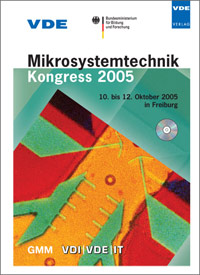Reduced Power Consumption of a Gradient Gas Sensor Microarray with Downsized Chip Geometry, Optimized Packaging And Nanogranular Gas Detection Layers
Conference: Mikrosystemtechnik Kongress 2005 - Mikrosystemtechnik Kongress 2005
10/10/2005 - 10/12/2005 at Munich, Germany
Proceedings: Mikrosystemtechnik Kongress 2005
Pages: 4Language: englishTyp: PDF
Personal VDE Members are entitled to a 10% discount on this title
Authors:
Goschnick, Joachim; Walter, Thomas; Schneider, Thomas (Forschungszentrum Karlsruhe, Deutschland)
Frietsch, Markus (SYSCA AG, Knittlingen, Deutschland)
Abstract:
Low power consumption is often demanded for gas sensor arrays, e.g. to allow battery operation. Although gas sensing with semiconducting metal oxides, usually operated at some 100deg C, requires heating it is often favored because of its superior gas sensitivity, broadband gas detectability, rapid response, chemical robustness and ease of fabrication. The Karlsruhe Micronose KAMINA combines the advantages of this gas sensing principle with the low power consumption of a unique microsystem based on a single metal oxide film only subdivided by parallel electrode strips into a suite of sensor segments forming a gradient gas sensor microarray. The initially identical sensor segments are differentiated in their gas sensing properties by a temperature gradient and a thickness gradient of a gas permeable coating with a few nm variation across the array. Because of the gradually different gas response of the segments gas characteristic signal patterns are obtained sensitively depending on the gas composition the chip is exposed to. A novel generation of gradient microarrays, a completely new packaging and the use of metal oxide nanoparticles rather than sputtered layers allowed to reduce the power consumption significantly: So far oxidized Si/SiO2-wafers have been used as substrates of the 9x10mm2 chips mounted onto a Pin-Grid-Array (PGA) with ceramic columns. 250–300deg C across the array required 6.7 W. Replacing the substrate material Si/SiO2 by Al2O3 and reducing the substrate size to 3??3.5 mm2 decreased the required power to 1.6W. A novel fastening of the chip fixing the chip trampoline-like in a clearance of a ceramic carrier card only with its contact wires gave another substantial decrease in the power consumption due to the minimization of the chip’s heat loss to the carrier. A microarray of this type with 16 SnO2 segments on Al2O3 mounted in a ceramic card carrier requires less than 1 W for 250deg-300deg C operation which is only 15% of the power formerly consumed. Nevertheless, the gas analytical performance could be maintained, especially the same gas discrimination power was obtained as with the original large microarray. Another 30% of operation power can be saved by replacing the sputtered metal oxide by a layer of nanoparticles the size of 20nm or less because the operation temperature of such layers is significantly lower. Moreover, the open structure of such nanogranular layers permits a much faster response speed.


